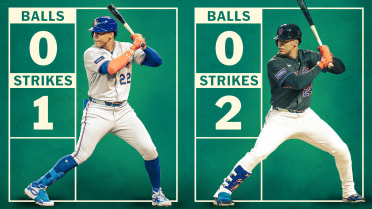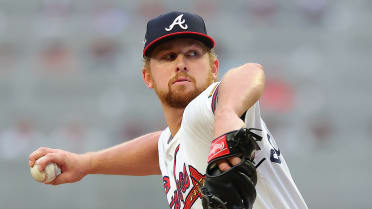Calvin Jones, Marty Lamb, Mike Brito, Josh Herzenberg and Tom Kunis are not on the Dodgers' roster. But without them, Clayton Kershaw, Walker Buehler, Julio Urías, Dustin May and Tony Gonsolin might not be on the roster, either.
The unsung quintet is the group of scouts credited with signing the homegrown starting rotation that has helped put the top-seeded Dodgers into the best-of-five National League Division Series against the upstart Padres in Arlington.
For an organization that has changed coasts, changed a nation's social consciousness and changed owners three times from 1998-2012, there is something that seemingly never changes -- the Dodgers’ reputation for elite pitching.
That has been the Dodgers' brand for nearly a century. In the last 82 seasons, the Dodgers staff has ranked either first or second in league ERA 42 times, including this year, when it ranked first.
Buehler and Kershaw are the twin aces and will start the first two games. Buehler showed in Game 1 of the NL Wild Card Series that his four-seam fastball can still overwhelm, at least for as long as his finger blister allows. Management is trying to win now and later, threading that needle by rationing Buehler’s pitches to contain the irritation. Then in Game 2, Kershaw dealt his skeptics a setback when he offered eight vintage innings to clinch.
In the Wild Card Series, Urías piggybacked Buehler with three scoreless innings. Manager Dave Roberts said any of his other three starters could follow Buehler, or Los Angeles could use relievers. The Dodgers haven’t announced starters beyond Kershaw. While Urías has the most postseason experience, rookies Gonsolin and May at least enjoyed prominent usage filling in after David Price elected not to play this year.
Kershaw and Buehler were can’t-miss first-round Draft picks by different regimes, and the only suspense in the Draft room was whether they would still be on the board when the Dodgers’ turn came. The road to the rotation for the other three illustrates the varied methods the Dodgers discover and polish pitching talent.
Urías was signed on his 16th birthday by Brito and then-scouting director Logan White during a trip primarily designed to secure the services of outfielder Yasiel Puig, who had fled Cuba and was working out and entertaining offers in Mexico. Victor González, now a key Dodgers rookie reliever, was part of the player package that included Urías.
Brito -- an international scouting legend for signing Fernando Valenzuela a generation earlier -- was first alerted to Urías two years earlier and immediately began the sales pitch, telling the 14-year-old he would be a Dodger just like Valenzuela. Left shoulder capsule surgery in 2017 threatened Urías' career, but he finally cracked the rotation this year and held up physically.
May, 23, was a gangly Texas high schooler taken in the third round because he steadily trended upward every time he was seen by Herzenberg, who has since taken his talents to be director of research and development for Lotte in the Korean Baseball League, overseeing analysts in the front office.
Herzenberg said May went from a “back-pocket follow” to a target when his fastball jumped from 90 mph to 94 mph when he and national crosschecker Jack Cressend watched. Cressend also had been instrumental supporting Lamb’s scouting of Buehler a year earlier. Now May has a 99 mph sinker with so much movement it can make Manny Machado’s jaw drop and the Internet break.
“The Dodgers' scouting department did a great job weighing all the pros and cons and handing the fantastic player development staff a template with which to work,” said Herzenberg, who estimated that at least six scouts saw May pitch his senior season of high school.
Gonsolin’s story is the most unlikely. A two-way player who loved to bat, he went undrafted out of high school and again as a junior at St. Mary’s College in northern California, where he mostly played outfield but occasionally pitched in the shadow of their Friday night ace, future Brewer Corbin Burnes. Dodgers scouting supervisor Paul Cogan tried to sign Gonsolin as a free agent after his junior year but Gonsolin said no and went back for his senior season. A year later, the Dodgers made him their ninth-round Draft pick and secured him for $2,500, a tactic clubs use to save top-10 signing bonuses for more valued picks, knowing that college seniors have no leverage.
“They would bring him in from right field to relieve, and he’d be firing bullets. He was super competitive, had ice in his veins -- what’s not to like?” recalled Kunis, who was a long-time college pitching coach before scouting for the Dodgers. “When we took him, it was a weird phone call. I mean, $2,500? I was a little nervous he might balk at it. He was excited to go inside 10 rounds, and he took it. He just wanted a chance to prove he could play. I was ecstatic, and somewhat surprised.”
Gonsolin’s money pitch is a splitter/changeup he learned from former Dodgers reliever Joel Peralta, now a Minor League instructor. A timely example of the collaboration between the scouts that acquire the prospects and the development department that refines them.
“Joel showed him that grip, planted the seeds,” Kunis said. “The addition of that pitch ultimately was the game-changer to the big leagues.”
Ken Gurnick covered the Dodgers for MLB.com from 2001-2020.




